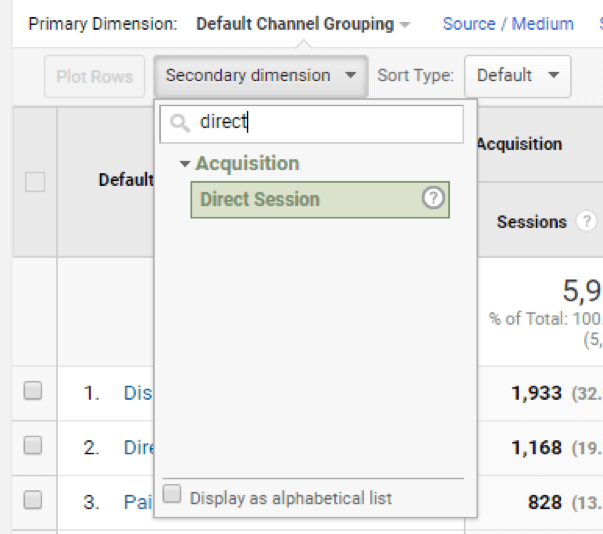Secondary Dimension in Google Analytics: Unlocking Advanced Metrics
Enhance Your Information Evaluation Making Use Of Second Measurement in Google Analytics
Discovering the capacities of additional measurements in Google Analytics opens a world of possibilities for refining information evaluation. By layering extra dimensions onto primary information sets, a more detailed narrative emerges, dropping light on user communications and efficiency signs.
Understanding Additional Measurements
In the world of data evaluation, a vital element to grasp is the principle of secondary dimensions and their significance in removing deeper insights from Google Analytics reports. Additional dimensions in Google Analytics describe extra specifications that can be contributed to the primary measurement, permitting an extra detailed analysis of information. By incorporating additional measurements, experts can section and filter data to discover patterns, fads, and relationships that may not appear when checking out the information all at once. These second measurements can offer context and a much more thorough understanding of user behavior, website traffic sources, and other essential metrics tracked by Google Analytics.

Benefits of Using Second Dimensions
When assessing data in Google Analytics, the use of second dimensions supplies very useful understandings into individual actions and performance metrics. By including a secondary measurement to your key data, you can delve much deeper right into the characteristics of your site site visitors and their interactions.
Additionally, additional dimensions enhance the context of your key data, offering a more comprehensive sight of user interaction and efficiency metrics. Overall, the usage of additional measurements in Google Analytics can dramatically improve the depth and top quality of your information evaluation, leading to more educated decision-making and improved outcomes.
Just How to Add Second Measurements
By including additional dimensions in Google Analytics, individuals can get much deeper insights right into their information evaluation process, enabling more comprehensive evaluation of customer actions and efficiency metrics. Adding second dimensions is a simple process that can considerably enhance the deepness of analysis. To add a second dimension in Google Analytics, begin by navigating to the report you wish to examine. As soon as in the record, find the "Secondary measurement" tab over the data table. Click it to disclose a dropdown food selection with various options such as Actions, Modern Technology, and Personalized Dimensions. Select the dimension you wish to add, such as 'Source/Medium' or 'Tool Category'. This additional dimension will certainly after that be applied to your existing information, supplying added context and allowing for a much more detailed evaluation of user communications. By making use of second measurements successfully, customers can uncover beneficial understandings that might have or else been neglected, bring about notified decision-making and boosted performance techniques.
Studying Data With Secondary Dimensions
Utilizing second dimensions in data analysis offers an extra detailed understanding of individual habits and performance metrics. By adding a second measurement to your main data embeded in Google Analytics, you can dive much deeper into the qualities of your web site site visitors and their interactions. As an example, incorporating the main dimension of 'source/medium' with the secondary measurement of go to website 'touchdown page' can expose which particular pages are drawing in website traffic from different resources, aiding you maximize these web pages for far better interaction.

Fundamentally, assessing data with secondary dimensions encourages you to get important understandings right into user actions, determine trends, and make informed choices to improve the efficiency of your digital residential or commercial properties.
Best Practices for Second Dimensions
In information analysis, including secondary dimensions effectively can substantially enhance the depth of understandings originated from metrics and individual habits patterns. When making use of secondary measurements in Google Analytics or any type of other logical tool, it is crucial to stick to finest practices to make certain the accuracy and significance of the data evaluation.
One key best method is to thoroughly select second measurements that complement the main dimension being assessed. Choosing secondary dimensions that supply added context or further segmentation can use an extra extensive understanding of the data. It is additionally necessary to stay clear of overcomplicating the evaluation by including way too many second measurements, which might bring about complication or dilution of insights.
Additionally, it is recommended to trying out various mixes of primary and second dimensions to discover new correlations and trends. Regularly refining the selection and evaluating of secondary dimensions based upon the certain goals of the evaluation can lead to even more workable understandings. By following these ideal practices, data analysts can utilize additional measurements effectively to boost the general information evaluation procedure and decision-making abilities.

Conclusion
To conclude, integrating second measurements in Google Analytics is important for a detailed information evaluation approach. By leveraging second dimensions alongside primary ones, content analysts and marketing professionals can discover useful insights and relationships that can inform decision-making and optimize digital advertising and marketing approaches. Recognizing exactly how to effectively utilize second dimensions and complying with finest practices will enable experts to draw out purposeful data and improve their overall efficiency metrics.
Second dimensions in Google Analytics refer to additional criteria you could try these out that can be included to the main dimension, enabling for a more detailed analysis of data. By integrating additional measurements, experts can section and filter information to reveal patterns, fads, and relationships that may not be apparent when looking at the data as a whole. Integrating the primary measurement of 'source/medium' with the additional measurement of 'touchdown page' can expose which details web pages are drawing in web traffic from various sources, assisting you optimize these pages for much better involvement.
One key best practice is to carefully select second measurements that match the primary dimension being examined. By complying with these finest methods, data experts can take advantage of secondary measurements properly to boost the overall data analysis process and decision-making capabilities.